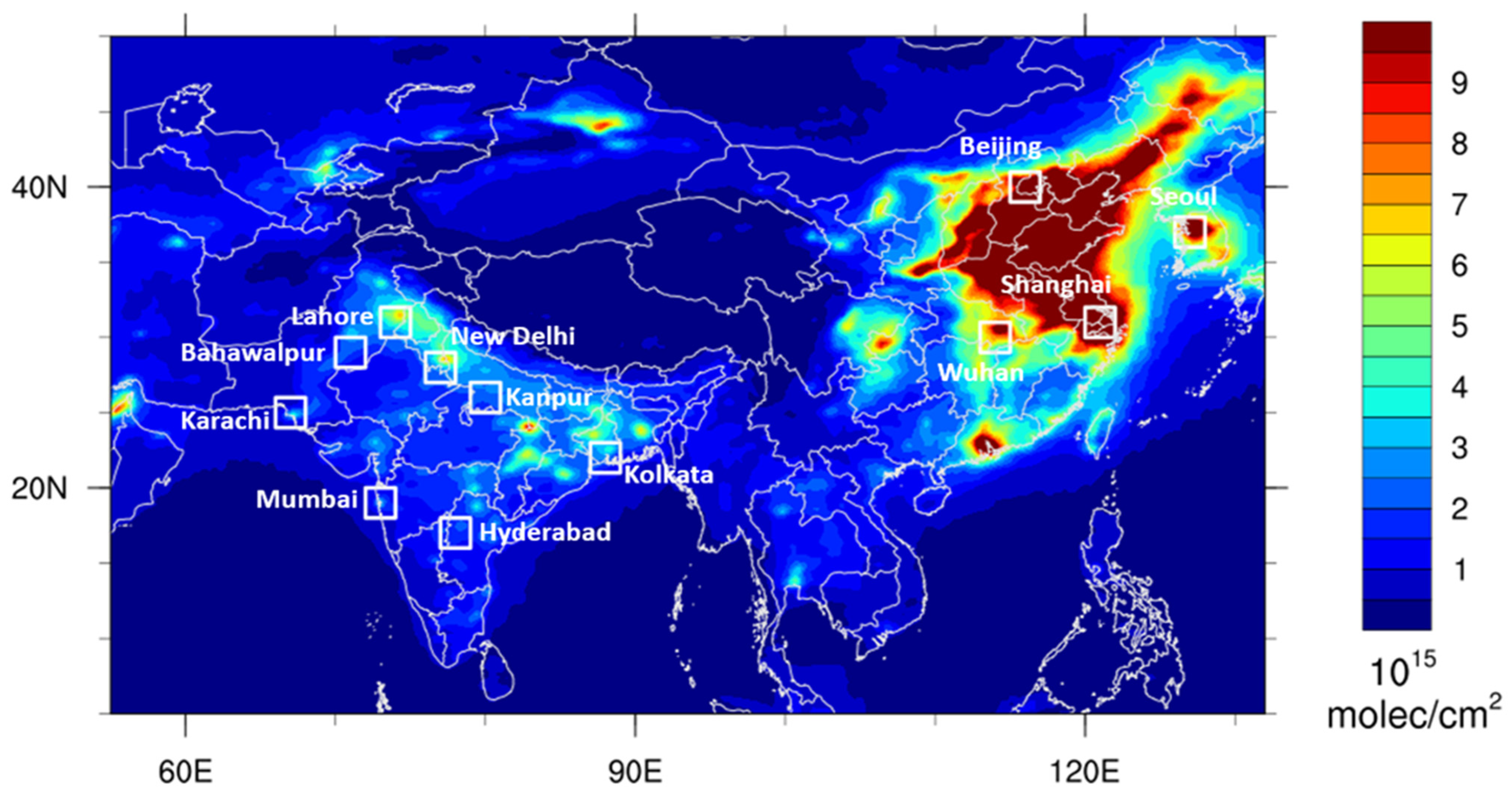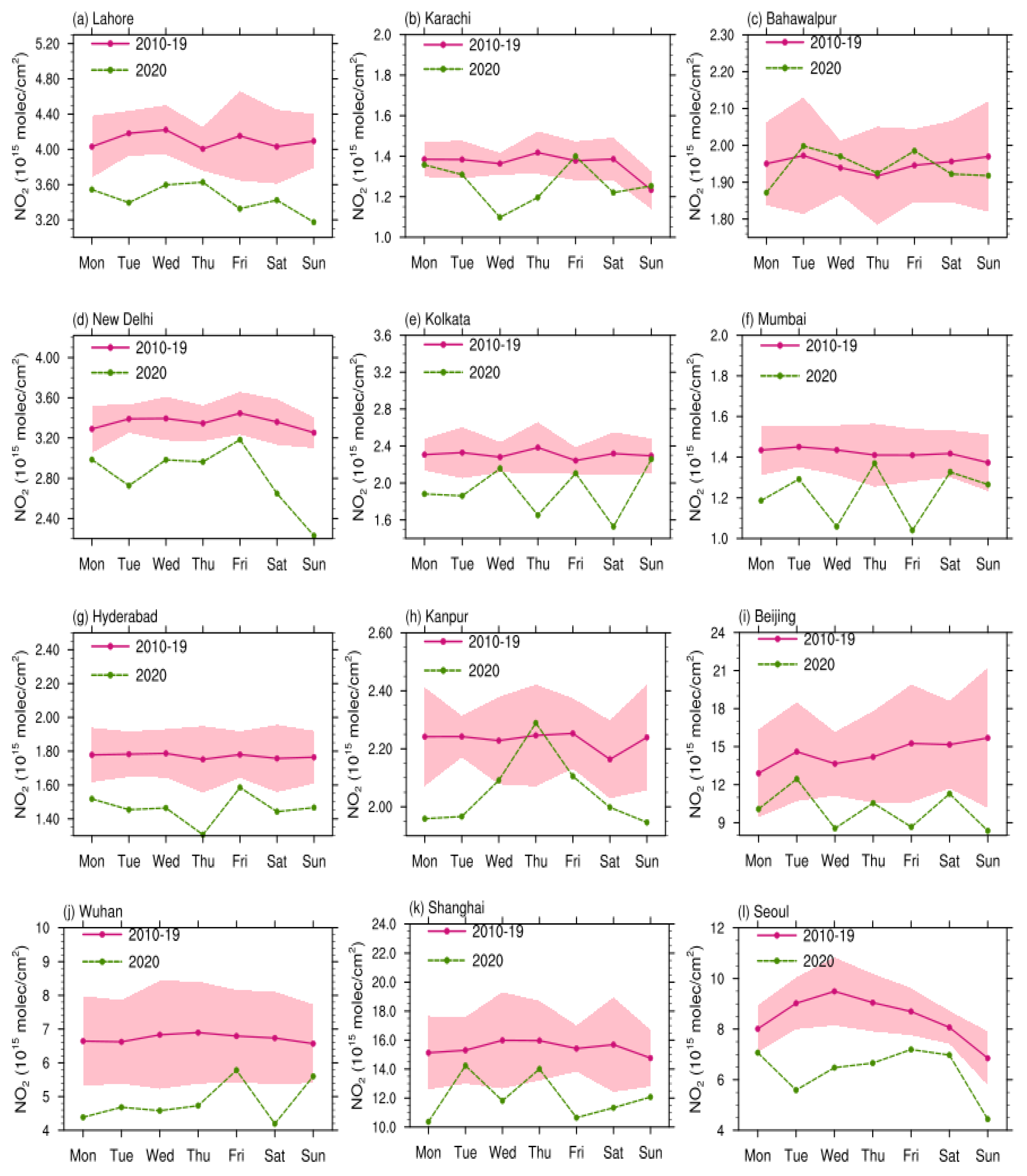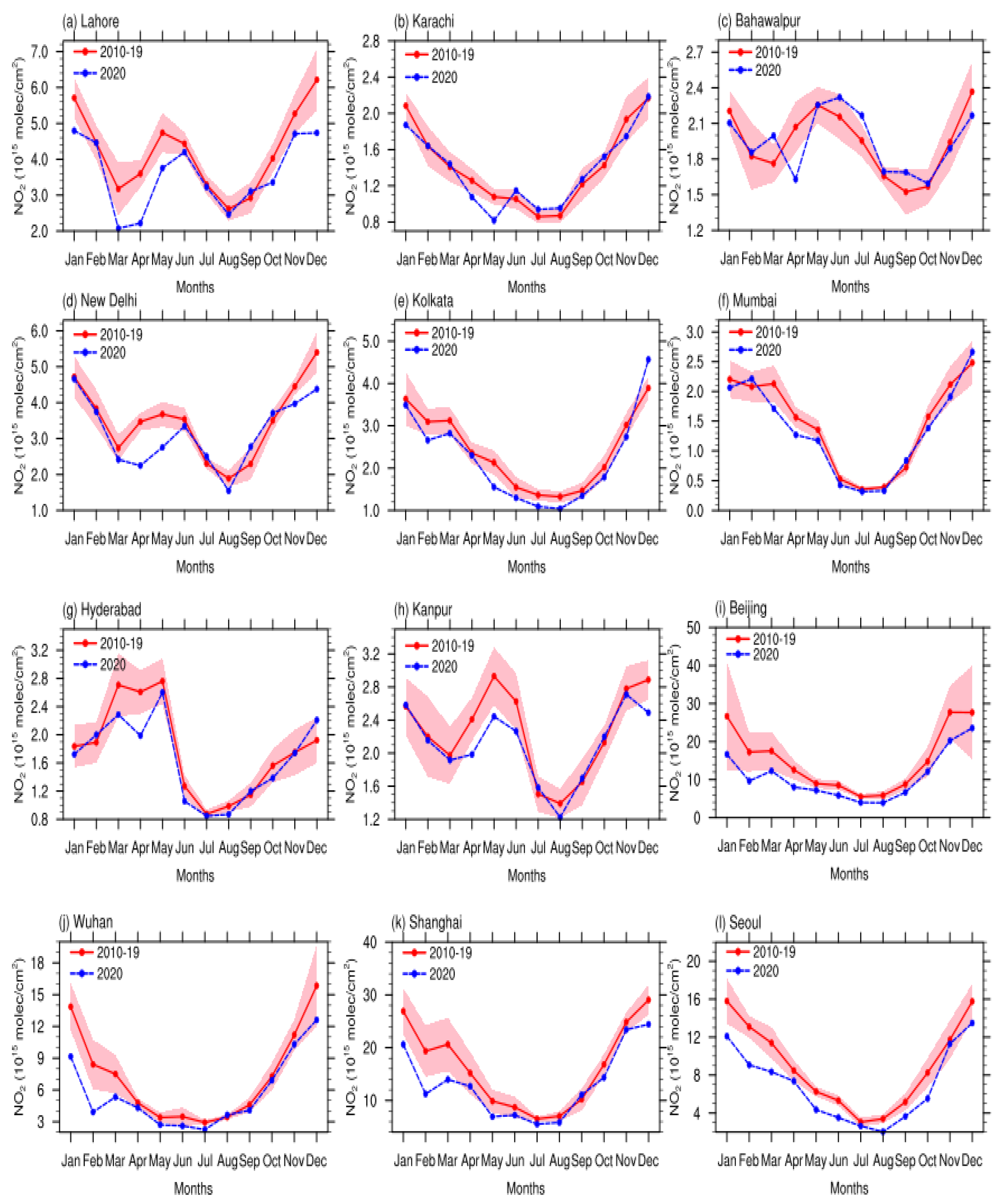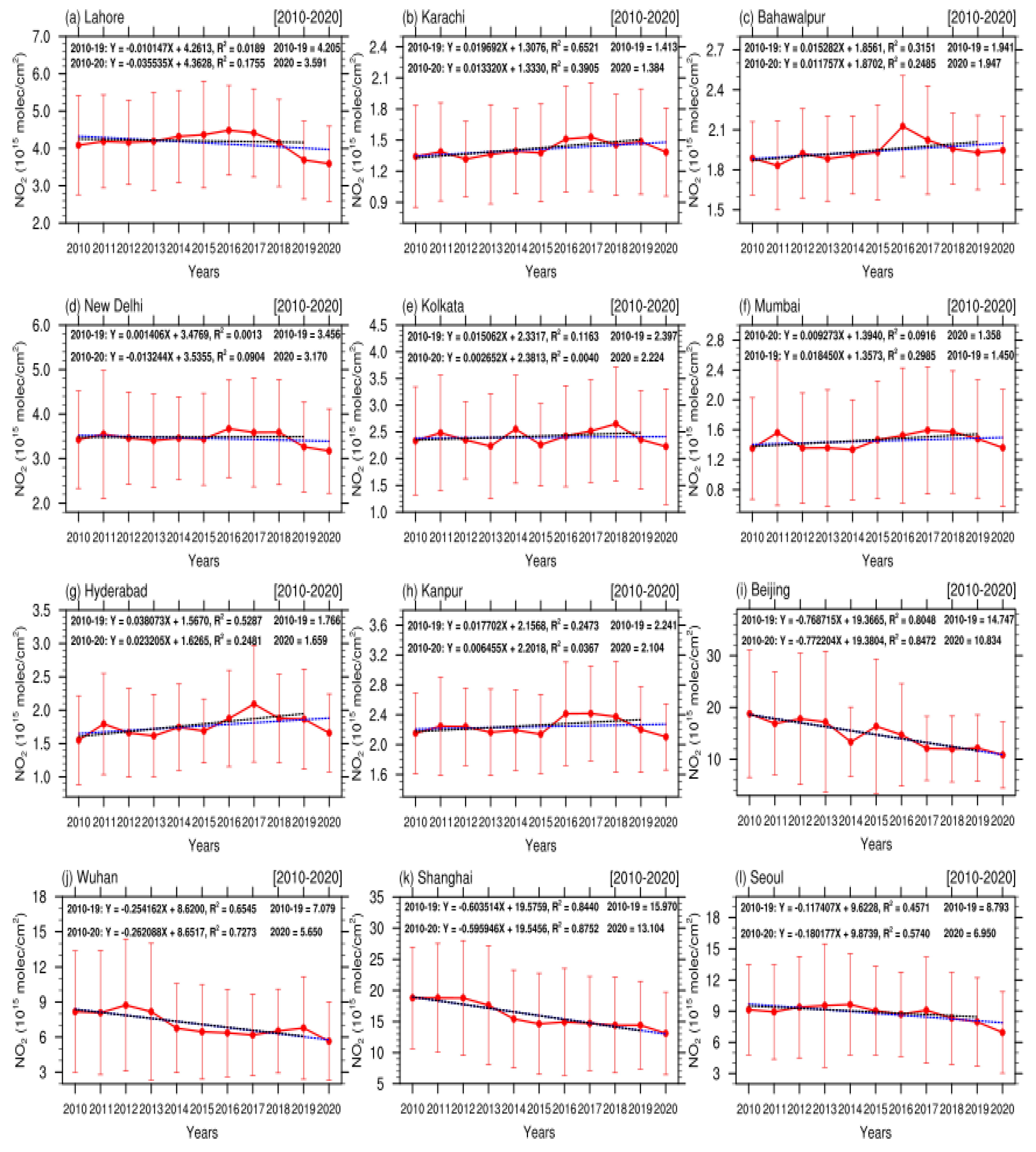Spatiotemporal Variations in the Air Pollutant NO2 in Some Regions of Pakistan, India, China, and Korea, before and after COVID-19, Based on Ozone Monitoring Instrument Data
Abstract
:1. Introduction
2. Materials and Methods
2.1. Study Area
2.2. Data Collection
3. Results and Discussion
3.1. Weekly Variation in NO2 Concentrations
3.2. Monthly Variation in NO2 Concentrations
3.3. Annual Mean Trends in NO2 Concentrations
3.4. A Possible Reason for the Reduced NO2 Emissions during the COVID-19 Period
4. Conclusions
Author Contributions
Funding
Institutional Review Board Statement
Informed Consent Statement
Data Availability Statement
Acknowledgments
Conflicts of Interest
References
- WHO. Available online: https://www.who.int/director-general/speeches/detail/who-director-general-s-opening-remarks-at-the-media-briefing-on-covid-19---11-march-2020 (accessed on 2 March 2022).
- WHO. Available online: https://www.worldometers.info/coronavirus/coronavirus-cases/ (accessed on 4 March 2022).
- Arshad, A.; Hussain, S.; Saleem, F.; Shafeeque, M.; Khan, S.; Waqas, M. Unprecedented reduction in airborne aerosol particles and nitrogen dioxide level in response to COVID-19 pandemic lockdown over the Indo-Pak region. Geophys. Res. Lett. 2020. [Google Scholar]
- Fauci, A.; Lane, H.; Redfield, R. COVID-19—Navigating the uncharted. N. Engl. J. Med. 2020, 382, 1268–1269. [Google Scholar] [CrossRef] [PubMed]
- Haffajee, R.; Mello, M. Thinking globally, acting locally—The U.S. response to COVID-19. N. Engl. J. Med. 2020, 382, e75. [Google Scholar] [CrossRef] [PubMed]
- Muhammad, S.; Long, X.; Salman, M. COVID-19 pandemic and environmental pollution: A blessing in disguise? Sci. Total Environ. 2020, 728, 138820. [Google Scholar] [CrossRef]
- Misra, P.; Takigawa, M.; Khatri, P.; Dhaka, S.; Dimri, A.; Yamaji, K.; Kajino, M.; Takeuchi, W.; Imasu, R.; Nitta, K.; et al. Nitrogen oxides concentration and emission change detection during COVID-19 restrictions in North India. Sci. Rep. 2021, 11, 9800. [Google Scholar] [CrossRef] [PubMed]
- Cohen, A.; Brauer, M.; Burnett, R.; Anderson, H.; Frostad, J.; Estep, K.; Balakrishnan, K.; Brunekreef, B.; Dandona, L.; Dandona, R.; et al. Estimates and 25-year trends of the global burden of disease attributable to ambient air pollution: An analysis of data from the global burden of diseases study 2015. Lancet 2017, 389, 1907–1918. [Google Scholar] [CrossRef] [Green Version]
- Hao, J.; He, K.; Duan, L.; Li, J.; Wang, L. Air Pollution and Its Control in China. Front. Environ. Sci. Eng. China 2007, 1, 129–142. [Google Scholar] [CrossRef]
- Wang, S.; Xing, J.; Chatani, S.; Hao, J.; Klimont, Z.; Cofala, J.; Amann, M. Verification of anthropogenic emissions of China by satellite and ground observations. Atmos. Environ. 2011, 45, 6347–6358. [Google Scholar] [CrossRef]
- IPCC. Available online: https://archive.ipcc.ch/report/ar4/wg1/ (accessed on 2 March 2022).
- WHO. Available online: www.euro.who.int (accessed on 8 March 2022).
- Cheng, M.; Jiang, H.; Guo, Z. Evaluation of long-term tropospheric NO2 columns and the effect of different ecosystem in Yangtze river delta. Proc. Environ. Sci. 2012, 13, 1045–1056. [Google Scholar] [CrossRef] [Green Version]
- US EPA. Nitrogen Dioxide (NO2) Pollution. Available online: https://www.epa.gov/no2-pollution (accessed on 5 March 2022).
- Mor, S.; Kumar, S.; Singh, T.; Dogra, S.; Pandey, V.; Ravindra, K. Impact of COVID-19 lockdown on air quality in Chandigarh, India: Understanding the emission sources during controlled anthropogenic activities. Chemosphere 2021, 263, 127978. [Google Scholar] [CrossRef]
- Jain, S.; Sharma, T. Social and travel lockdown impact considering coronavirus disease (COVID-19) on air quality in megacities of India: Present benefits, future challenges and way forward. Aerosol Air Qual. Res. 2020, 20, 1222–1236. [Google Scholar] [CrossRef]
- Singh, V.; Singh, S.; Biswal, A.; Kesarkar, A.; Mor, S.; Ravindra, K. Diurnal and temporal changes in air pollution during COVID-19 strict lockdown over different regions of India. Environ. Pollut. 2020, 266, 115368. [Google Scholar] [CrossRef] [PubMed]
- NASA. Available online: https://earthobservatory.nasa.gov/images/146362/airborne-nitrogen-dioxide-plummets-over-china (accessed on 12 March 2022).
- Dutheil, F.; Baker, J.; Navel, V. COVID-19 as a factor influencing air pollution? Environ. Pollut. 2020, 263, 114466. [Google Scholar] [CrossRef] [PubMed]
- World City Populations. Available online: https://worldpopulationreview.com/world-cities (accessed on 15 March 2022).
- Gautam, A.; Dilwaliya, N.; Srivastava, A.; Kumar, S.; Bauddh, K.; Siingh, D.; Shah, M.; Singh, K.; Gautam, S. Temporary reduction in air pollution due to anthropogenic activity switch-off during COVID-19 lockdown in northern parts of India. Environ. Dev. Sustain. 2020, 23, 8774–8797. [Google Scholar] [CrossRef]
- Zhao, F.; Liu, C.; Cai, Z.; Liu, X.; Bak, J.; Kim, J.; Hu, Q.; Xia, C.; Zhang, C.; Sun, Y.; et al. Ozone profile retrievals from TROPOMI: Implication for the variation of tropospheric ozone during the outbreak of COVID-19 in China. Sci. Total Environ. 2021, 764, 142886. [Google Scholar] [CrossRef]
- Levelt, P.; van den Oord, G.; Dobber, M.; Malkki, A.; Visser, H.; de Vries, J.; Stammes, P.; Lundell, J.; Saari, H. The Ozone Monitoring Instrument. IEEE Trans. Geosci. Remote Sens. 2006, 44, 1093–1101. [Google Scholar] [CrossRef]
- Pinardi, G.; Van Roozendael, M.; Hendrick, F.; Theys, N.; Abuhassan, N.; Bais, A.; Boersma, F.; Cede, A.; Chong, J.; Donner, S.; et al. Validation of tropospheric NO2 column measurements of GOME-2A and OMI using MAX-DOAS and direct sun network observations. Atmos. Meas. Tech. 2020, 13, 6141–6174. [Google Scholar] [CrossRef]
- Goldberg, D.; Lu, Z.; Oda, T.; Lamsal, L.; Liu, F.; Griffin, D.; McLinden, C.; Krotkov, N.; Duncan, B.; Streets, D. Exploiting OMI NO2 satellite observations to infer fossil-fuel CO2 emissions from U.S. megacities. Sci. Total Environ. 2019, 695, 133805. [Google Scholar] [CrossRef]
- Zhang, X.; Lu, X.; Liu, L.; Chen, D.; Zhang, X.; Liu, X.; Zhang, Y. Dry deposition of NO2 over China inferred from OMI columnar NO2 and atmospheric chemistry transport model. Atmos. Environ. 2017, 169, 238–249. [Google Scholar] [CrossRef]
- bp Statistical Review of Worlds Energy. Available online: https://www.bp.com/ (accessed on 13 March 2022).
- Cleveland, W.; Graedel, T.; Kleiner, B.; Warner, J. Sunday and workday variations in photochemical air pollutants in New Jersey and New York. Science 1974, 186, 1037–1038. [Google Scholar] [CrossRef]
- Tanvir, A.; Javed, Z.; Jian, Z.; Zhang, S.; Bilal, M.; Xue, R.; Wang, S.; Bin, Z. Ground-based MAX-DOAS observations of tropospheric NO2 and HCHO during COVID-19 lockdown and spring festival over Shanghai, China. Remote Sens. 2021, 13, 488. [Google Scholar] [CrossRef]
- Stavrakou, T.; Müller, J.; Bauwens, M.; Boersma, K.; van Geffen, J. Satellite evidence for changes in the NO2 weekly cycle over large cities. Sci. Rep. 2020, 10, 10066. [Google Scholar] [CrossRef] [PubMed]
- Ialongo, I.; Herman, J.; Krotkov, N.; Lamsal, L.; Boersma, F.; Hovila, J.; Tamminen, J. Comparison of OMI NO2 observations and their seasonal and weekly cycles with ground-based measurements in Helsinki. Atmos. Meas. Tech. 2016, 9, 5203–5212. [Google Scholar] [CrossRef] [Green Version]
- Richter, A.; Burrows, J.; Nüß, H.; Granier, C.; Niemeier, U. Increase in tropospheric nitrogen dioxide over China observed from space. Nature 2005, 437, 129–132. [Google Scholar] [CrossRef]
- Uno, I.; He, Y.; Ohara, T.; Yamaji, K.; Kurokawa, J.; Katayama, M.; Wang, Z.; Noguchi, K.; Hayashida, S.; Richter, A.; et al. Systematic analysis of interannual and seasonal variations of model-simulated tropospheric NO2 in Asia and comparison with GOME-satellite data. Atmos. Chem. Phys. 2007, 7, 1671–1681. [Google Scholar] [CrossRef] [Green Version]
- Cichowicz, R.; Wielgosiński, G.; Fetter, W. Dispersion of atmospheric air pollution in summer and winter season. Environ. Monit. Assess. 2017, 189, 105. [Google Scholar] [CrossRef] [PubMed] [Green Version]
- Zhao, N.; Li, B.; Li, H.; Li, G.; Wu, R.; Hong, Q.; Mperejekumana, P.; Liu, S.; Zhou, Y.; Ahmad, R.; et al. The potential co-benefits for health, economy and climate by substituting raw coal with waste cooking oil as a winter heating fuel in rural households of Northern China. Environ. Res. 2021, 194, 110683. [Google Scholar] [CrossRef]
- Wang, C.; Wang, T.; Wang, P. The spatial–temporal variation of tropospheric NO2 over China during 2005 to 2018. Atmosphere 2019, 10, 444. [Google Scholar] [CrossRef] [Green Version]
- Cui, Y.; Lin, J.; Song, C.; Liu, M.; Yan, Y.; Xu, Y.; Huang, B. Rapid growth in nitrogen dioxide pollution over Western China, 2005–2013. Atmos. Chem. Phys. 2016, 16, 6207–6221. [Google Scholar] [CrossRef] [Green Version]
- Zheng, C.; Zhao, C.; Li, Y.; Wu, X.; Zhang, K.; Gao, J.; Qiao, Q.; Ren, Y.; Zhang, X.; Chai, F. Spatial and temporal distribution of NO2 and SO2 in inner Mongolia urban agglomeration obtained from satellite remote sensing and ground observations. Atmos. Environ. 2018, 188, 50–59. [Google Scholar] [CrossRef] [Green Version]
- ul-Haq, Z.; Tariq, S.; Ali, M. Tropospheric NO2 trends over South Asia during the last decade (2004–2014) using OMI data. Adv. Meteorol. 2015, 2015, 959284. [Google Scholar] [CrossRef] [Green Version]
- Hickman, J.; Andela, N.; Tsigaridis, K.; Galy-Lacaux, C.; Ossohou, M.; Bauer, S. Reductions in NO2 burden over north equatorial Africa from decline in biomass burning in spite of growing fossil fuel use, 2005 to 2017. Proc. Natl. Acad. Sci. USA 2021, 118, e20025791118. [Google Scholar] [CrossRef]
- Abbas, S.; Ali, G.; Qamer, F.; Irteza, S. Associations of air pollution concentrations and energy production dynamics in Pakistan during lockdown. Environ. Sci. Pollut. Res. 2022, 29, 5036–35047. [Google Scholar] [CrossRef]




| Country | City | Population |
|---|---|---|
| Pakistan | Lahore | 13,542,000 |
| Karachi | 16,840,000 | |
| Bahawalpur | 895,000 | |
| India | New Delhi | 32,066,000 |
| Kolkata | 15,134,000 | |
| Mumbai | 20,961,000 | |
| Hyderabad | 10,534,000 | |
| Kanpur | 3,190,000 | |
| China | Beijing | 21,333,000 |
| Wuhan | 8,592,000 | |
| Shanghai | 28,517,000 | |
| South Korea | Seoul | 9,976,000 |
| City | Min 2010–2019 | Min 2020 | Max 2010–2019 | Max 2020 | Mean 2010–2019 (A) | Mean 2020 (B) | Difference (A–B) |
|---|---|---|---|---|---|---|---|
| Lahore | 2.61 (August) | 2.07 (March) | 6.21 (December) | 4.79 (January) | 4.20 | 3.59 | 0.61 |
| Karachi | 0.85 (July) | 0.81 (May) | 2.16 (December) | 2.18 (December) | 1.41 | 1.38 | 0.03 |
| Bahawalpur | 1.52 (September) | 1.59 (October) | 2.36 (December) | 2.31 (June) | 1.94 | 1.94 | 0 |
| New Delhi | 1.89 (August) | 1.54 (August) | 5.39 (December) | 4.65 (January) | 3.48 | 3.17 | 0.31 |
| Kolkata | 1.32 (August) | 1.04 (August) | 3.89 (December) | 4.56 (January) | 2.41 | 2.22 | 0.19 |
| Mumbai | 0.35 (July) | 0.31 (July) | 2.48 (December) | 2.66 (December) | 1.45 | 1.35 | 0.10 |
| Hyderabad | 0.87 (July) | 0.84 (July) | 2.76 (May) | 2.60 (May) | 1.77 | 1.65 | 0.12 |
| Kanpur | 1.39 (August) | 1.22 (August) | 2.93 (May) | 2.70 (November) | 2.25 | 2.10 | 0.15 |
| Beijing | 5.49 (July) | 3.90 (August) | 27.71 (November) | 23.57 (December) | 15.13 | 10.83 | 4.30 |
| Wuhan | 2.92 (July) | 2.25 (July) | 15.83 (December) | 12.61 (December) | 7.22 | 5.64 | 1.57 |
| Shanghai | 6.50 (July) | 5.52 (July) | 29.04 (December) | 24.42 (December) | 16.25 | 13.10 | 3.15 |
| Seoul | 3.05 (July) | 2.03 (August) | 15.80 (January) | 13.49 (December) | 8.97 | 6.95 | 2.02 |
| City | Yearly Trend (2010–2019) | Yearly Trend (2010–2020) | Difference |
|---|---|---|---|
| Lahore | −0.24% | −0.85% | −0.61% |
| Karachi | 1.39% | 0.94% | −0.45% |
| Bahawalpur | 0.78% | 0.60% | −0.18% |
| New Delhi | 0.04% | −0.38% | −0.42% |
| Kolkata | 0.62% | 0.11% | −0.51% |
| Mumbai | 1.26% | 0.63% | −0.63% |
| Hyderabad | 2.14% | 1.31% | −0.83% |
| Kanpur | 0.78% | 0.28% | −0.50% |
| Beijing | −5.07% | −5.23% | −0.16% |
| Wuhan | −3.51% | −3.70% | −0.19% |
| Shanghai | −3.71% | −3.73% | −0.02% |
| Seoul | −1.30% | −2.04% | −0.74% |
| Country | Oil | Coal | Natural Gas | ||||||
|---|---|---|---|---|---|---|---|---|---|
| 2009–2019 | 2020 | Difference | 2009–2019 | 2020 | Difference | 2009–2019 | 2020 | Difference | |
| Pakistan | 0.2% | −2.5% | −2.7% | 10.5% | 11.0% | 0.5% | 2.5% | −7.5% | −10.0% |
| India | 4.5% | −9.9% | −14.4% | 4.7% | −6.0% | −10.7% | 1.9% | 0.3% | −1.6% |
| China | 5.3% | 1.7% | −3.6% | 1.5% | 0.3% | −1.2% | 13.1% | 6.9% | −6.2% |
| South Korea | 1.7% | −5.3% | −7.0% | 1.8% | –12.2% | −14.0% | 4.7% | 0.8% | −3.9% |
Publisher’s Note: MDPI stays neutral with regard to jurisdictional claims in published maps and institutional affiliations. |
© 2022 by the authors. Licensee MDPI, Basel, Switzerland. This article is an open access article distributed under the terms and conditions of the Creative Commons Attribution (CC BY) license (https://creativecommons.org/licenses/by/4.0/).
Share and Cite
Naeem, W.; Kim, J.; Lee, Y.G. Spatiotemporal Variations in the Air Pollutant NO2 in Some Regions of Pakistan, India, China, and Korea, before and after COVID-19, Based on Ozone Monitoring Instrument Data. Atmosphere 2022, 13, 986. https://doi.org/10.3390/atmos13060986
Naeem W, Kim J, Lee YG. Spatiotemporal Variations in the Air Pollutant NO2 in Some Regions of Pakistan, India, China, and Korea, before and after COVID-19, Based on Ozone Monitoring Instrument Data. Atmosphere. 2022; 13(6):986. https://doi.org/10.3390/atmos13060986
Chicago/Turabian StyleNaeem, Wardah, Jaemin Kim, and Yun Gon Lee. 2022. "Spatiotemporal Variations in the Air Pollutant NO2 in Some Regions of Pakistan, India, China, and Korea, before and after COVID-19, Based on Ozone Monitoring Instrument Data" Atmosphere 13, no. 6: 986. https://doi.org/10.3390/atmos13060986
APA StyleNaeem, W., Kim, J., & Lee, Y. G. (2022). Spatiotemporal Variations in the Air Pollutant NO2 in Some Regions of Pakistan, India, China, and Korea, before and after COVID-19, Based on Ozone Monitoring Instrument Data. Atmosphere, 13(6), 986. https://doi.org/10.3390/atmos13060986






